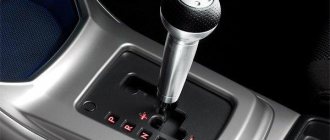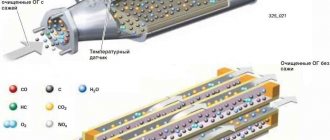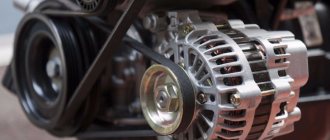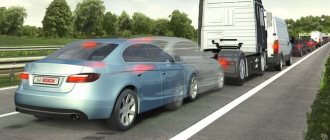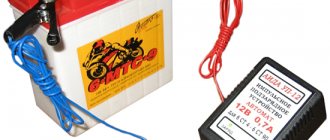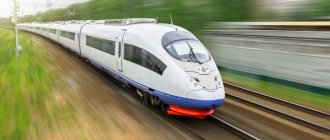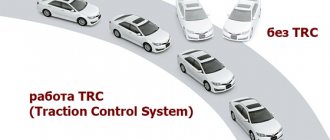The vehicle's exchange rate stabilization system in motion has a 20-year history of development, during which it received universal recognition, and is currently used on almost all models of modern cars. It is designed to automatically adjust the vehicle's directional position in skidding conditions.
ESP stabilizes the car's position in skidding conditions
Each automobile manufacturer called the stability control system differently on their models. Therefore, it has many different abbreviated names that can mislead inexperienced motorists. The first automatic exchange rate stabilization systems for German Mercedes Benz and BMW cars were called Elektronisches Stabilitatsprogramm.
ESP and its synonyms
The abbreviation of this name ESP has become the most widespread and is used by almost European and American car manufacturers. On other models you can find the following abbreviations and names of the stability control system:
- on Hyundai, Kia, Honda models it is usually called Electronic Stability Control ESC;
- on Rover, Jaguar, BMW models, Dynamic Stability Control (DSC) is installed;
- on Volvo it is called Dynamic Stability Traction Control - DTSC;
- on the Japanese brands Acura and Honda it is called Vehicle Stability Assist - VSA;
- Toyotas use the name Vehicle Stability Control - VSC;
- the same equipment under the name Vehicle Dynamic Control (VDC) is used on Subaru, Nissan and Infiniti cars.
Despite the large number of names, all this equipment is used to achieve one goal - to help the driver cope with control on slippery, wet or gravel roads, where maneuvering the vehicle leads to skidding and loss of course.
Introduction of the concept into the automotive industry
The story begins with a patent from 1959. At that time, no one knew the concept of “exchange rate control system”, what it was, and the module was called a control device. The author of the patent was the reputable Daimler-Benz. After that, it took almost 35 years of work to implement the development in real production cars. Although before this there were attempts to introduce a program for stabilizing car traffic that was not so perfect at that time and rather cumbersome.
Since 1995, the first to learn what ESP is in a car were the owners of the stylish Mercedes-Benz CL 600 coupe at that time. At that time it contained 11 different elements, unlike today, where their number was reduced to four . Some time later, the system became mandatory for company vehicles classified as SL and S.
Until 1998, serial installation was carried out on class A cars, but the cars were often recalled by the company, since the optional module caused certain difficulties. A year later, everything returned to normal, and ESP became standard equipment in most model classes.
Bosch is rightfully considered the European leader in the production of directional stability systems. It implements its products on products of such recognized world leaders as Volkswagen, Porsche, BMW, Audi, etc.
You need to know that the installation of ESP units on vehicles since 2011 has been a necessary procedure when new cars leave the assembly line in the European Union region, Canada and the United States.
Before explaining the operation of the ESP stability control system and what it is in a car, it is necessary to understand the terminology. After all, it is also called the dynamic stabilization system. Also, various global companies involved in the production of motor vehicles use their own developments in this area and use a personal designation.
There are various auto company abbreviations to describe the system, which we will decipher:
- ESP (Electronic Stability Program);
- VDC (Vehicle Dynamic Control);
- VSC (Vehicle Stability Control);
- VSA (Vehicle Stability Assist);
- DTSC (Dynamic Stability Traction Control);
- ESC (Electronic Stability Control).
If one of these designations is included among the functions of the purchased car, then this is an excellent signal for the driver.
Stability control system through the eyes of experts
The main goal of this system is to prevent the car from slipping into a skid and lateral sliding by changing the transmitted torque to one of the wheels of the drive pair. At the same time, further development of the skid that has begun is prevented and the position of the car on the trajectory of movement is stabilized during the maneuver on a slippery road. In some technical sources, it is called an anti-skid system, because such ESP in a car eliminates skidding and thereby ensures stability of course holding.
This picture clearly illustrates the operation of the ESP system, which keeps the car in a sharp turn.
The effectiveness of using automatic exchange rate stabilization equipment is confirmed by scientific research conducted by experts from the American Institute IIHS. Based on the results of the studies, it was revealed that the use of ESP in cars involved in a traffic accident reduced the mortality rate of accidents from 43 to 56%. Fatal vehicle rollover incidents have decreased by 77-80%. A vehicle equipped with ESC is significantly less likely to roll over than a vehicle not equipped with it.
Data from German insurance companies indicate that 35-40% of all fatal accidents could have been prevented or had a more favorable outcome if a stability control system had been installed on the cars of their participants. According to experts, this equipment definitely helps the motorist in extreme situations. In many cases, it is a lifesaver for inexperienced car enthusiasts.
When to turn off ESP
Heated debates arise around turning off the stabilization system. On one side of the line are drivers with hot blood - lovers of thrills and extreme skid angles. On the other hand, there are experienced drivers who present the argument that the stabilization system makes it difficult to get out of a very strong skid. In order to dispel unnecessary myths regarding disabling ESP, we list its disadvantages:
- ESP does not know how to bring front-wheel drive cars out of a strong skid, because this requires not a decrease, but a sharp increase in torque on the front wheels.
- On all-wheel drive vehicles in icy conditions, increasing torque is also preferable to braking.
- ESP behaves inappropriately on loose snow at low speeds.
- On heavily deflated wheels, ESP can greatly interfere with the driver.
Sometimes the ESP system needs to be turned off
The system has one plus, and it covers all the above-mentioned disadvantages - the ESP reaction speed in emergency situations is much higher than that of a person. In most cases, the driver is behind the wheel and is unfamiliar with extreme driving techniques, which means that the stability control system will become a lifeline for him in situations that require immediate action. As a bonus, the system adds a significant amount of driving comfort by eliminating body roll during cornering and spirited driving.
You should turn off ESP if you need to drive a little off-road, say, climbing on damp grass, soil or snow, when leaving an icy city parking lot and in other situations when the stabilization system is not required, and its operation is a false safety measure. In all of the above conditions, the system will “choke” the engine and prevent it from overcoming the current road conditions.
It is important! When leaving a deep rut, do not turn off ESP, since most modern sedans are equipped with a traction control system that works in tandem with it.
Design and operation of ESP equipment
Modern exchange rate stability control equipment works in conjunction with the ABS anti-lock wheel system, at the same time using its mechanisms. A single complex of these two systems works in concert, simultaneously performing several procedures to ensure safe vehicle movement. The structure of the directional stability system consists of:
- a control unit, which is a controller that continuously scans the state of various alarms and reads their signals;
- ABS sensors that determine wheel speed;
- steering wheel rotation sensors;
- pressure sensors in brake cylinders;
- G-sensor, a device sensitive to the lateral speed and acceleration of the vehicle and detecting the occurrence of slipping in the lateral direction.
Thus, the controller inputs constantly contain information about the speed of movement, the steering angle, engine speed, pressure in the brake cylinders, the angular velocity of lateral slip and its gradient. Information from the sensors is continuously compared with the calculated data programmed in the controller. If there are deviations, the controller generates corrective control signals that are sent to the actuators of the brake cylinders, braking the corresponding wheels to return the vehicle's trajectory to the calculated curve.
The choice of braking wheels and the degree of their braking is determined by the system automatically and individually, depending on the situation. To automatically brake the wheels, a hydraulic ABS modulator is used, which creates additional pressure in the brake cylinders. At the same time, a leading signal is sent to the engine fuel supply system, which reduces the flow of the combustible mixture. As a result, simultaneously with braking, the torque supplied to the wheel is reduced.
On-board computer notification “ESP Service”: problems and their elimination
Numerous electronic safety assistants, which are equipped with the latest generation Opel models, work in tandem. Damage to each sensor is reflected in separate alphanumeric error codes on a small display and in the archive of the on-board computer. To summarize the failure of the control electronics functions of the same type (built on a common base) of the Astra J, Insignia, Zafira, Mokka models, the “ESP Service” notification lights up on the central display of the on-board computer.
It is clear to experts that Opel programmers and localizers have chosen a gentle form of warning. An unprepared driver may perceive it as a reminder about the next maintenance. In fact, a warning about damage to electronic assistance systems warns of serious problems that could lead to a serious road accident.
Reasons for the notification
The exchange rate stability system (ESP), consisting of external sensors, a control unit and an actuator, works in conjunction with other electronic safety assistants - ABS, EDS, EBD, ASR. Receiving information from sensors about changes in the steering angle, operation of the brake and accelerator pedals, the control unit issues commands to the executing valve body. If necessary, the mechanisms of brake force distribution, wheel and differential locking, and traction control systems also come into play.
By analyzing the trajectory of the vehicle and the actions of the driver, the electronics can intervene in control in dangerous situations by changing engine speed (resetting and gaining power) and braking individual wheels. So, when the car skids, the exchange rate stability system first brakes the front outer wheel and reduces power (reducing the fuel supply to the engine), and later it adds speed and removes the braking force.
The “ESP Service” warning light may light up if any of the electronic assistant sensors, control units, wheel bearings, or valve body malfunctions. A message that is harmless in form indicates a serious electronic malfunction. Incorrect intervention of electronic assistants in driving can lead to a serious accident. It is not difficult to imagine a situation when, when dynamically overtaking a transport convoy, the electronics will begin to reduce engine speed and steer towards the overtaken truck.
In practice, ESP sensors in Opel models rarely fail. More often, the signal appears when ABS sensors, wheel bearings, or the traction control control unit are damaged. The most serious situation is when the “ESP Service” signal is accompanied by the “Check End” icon on the instrument panel and jerks during acceleration. In this case, damage to the electronics is accompanied by misfire in one of the engine cylinders. It is dangerous to continue driving; you need to stop and call a tow truck.
Troubleshooting Techniques
All electronic damage can be easily diagnosed by analyzing the error code archive of the Opel on-board computer. Using error codes, an experienced programmer localizes failed sensors and determines software failures of electronic control units. Auto mechanics can only replace damaged sensors.
Examples and features of the ESP system
To visualize what ESP is in a car, pay attention to the pictures.
In this illustration everything is clearly visible and clear.
This picture shows the lines of probable movement of a car when exceeding the maximum permissible speed when entering a sharp turn on the highway. When you turn the steering wheel, the car begins to skid. In the left picture, the red dotted line shows the line of movement of a car without ESC when the driver brakes (the car turns across and enters the oncoming lane). In the right figure, the red dotted line indicates the trajectory of movement without braking, when the car drifts into a ditch. The green line and torches in both pictures indicate the trajectory of a car equipped with an ESC system and the wheels, which are automatically braked by the system when a skid occurs.
Thanks to selective braking of the ESP system, the direction of movement of the vehicle is stabilized
The control system is triggered and operates in any situation, be it acceleration, coasting or braking. The operating algorithm of the control circuit is determined by the emerging situation and the wheel drive system. For example, if the rear axle skid sensor is triggered when the car is turning left, the ESC reduces the fuel supply to the engine and slows down the speed. If this measure does not eliminate the skid, then partial braking of the front right wheel occurs. This operation is followed by further action according to the established program until the resulting lateral slip of the rear wheels is eliminated.
ESP provides the ability to regulate the transmission in cars with electronic transmission. In such cars, automatic switching to a lower gear occurs when slipping occurs, similar to the winter driving method. Experienced drivers who are accustomed to driving at maximum speeds and capabilities note that the course stabilization system makes it difficult to drive a car in this mode.
ESP car stabilization system. Management principles
Such situations may arise at certain moments when it is necessary to increase engine thrust, but the control system, on the contrary, reduces it, eliminating the car from sliding. For such cases, designers install switches with which you can forcibly turn off the control system and exercise completely manual control of the car.
Equipment for automatic course stabilization is included in the on-board active safety system of the vehicle. The main advantage of the system is that a car equipped with it becomes more obedient and undemanding to the driver’s qualifications. He only needs to turn the steering wheel, and the system then independently performs all the necessary actions for the correct execution of the maneuver.
However, you should always remember that this system also has limits to its capabilities. If the speed is too high or the turning radius is too small, even the most advanced stability control system will not be able to save the car from an uncontrolled skid and rollover.
Such an issue as safety worried the first car designers at the dawn of the automobile industry. Since then, security systems have been constantly improved, helping modern car owners get out of difficult situations at a critical moment. Let's look at one of these new systems and find out what ESP is in modern cars.
These days, the ESP (Electronic Stability Program)
.
We call it the exchange rate stability system
. It is designed to control vehicle stability in critical situations, preventing the vehicle from skidding and preventing lateral sliding. The system also helps to hold the car when performing sharp maneuvers at high speed or on poor road surfaces.
They first tried to use such safety devices in the middle of the last century, but a truly working version was only introduced to production cars in 1995. Today it is used on almost all cars, regardless of their class and cost.
Let's figure out how this device works.
ESP system. Operating principle and advantages of the stabilization system
We will try to explain why there is an ESP system in a car and how it works.
The ESP (Electronic Stability Program) stabilization system is one of the most important active safety features in a car. If seat belts and airbags protect in the event of a collision (passive safety systems), then the stability control system can prevent accidents.
ESP was a continuation of the development of the anti-lock braking system ( Anti-lock braking system, abbr.
ABS) and traction control systems (Traction control or ASR). ABS helps reduce braking distances on asphalt and maintain control over the vehicle's handling during emergency braking, while ASR helps ensure confident acceleration. ESP is responsible for maintaining the vehicle's trajectory specified by the driver during turns or maneuvers.
The vehicle stability control system prevents understeer and oversteer. Simply put, ESP fights the drift of the front axle wheels and the car's skidding when speeding, especially on slippery road surfaces.
ESP, in addition to ABS sensors that monitor the rotation speed of all wheels, includes sensors for rotation around the vertical axis of the vehicle, steering angle and lateral acceleration. The data received from these sensors is processed in the ESP central control unit.
The stabilization system constantly monitors the vehicle's trajectory, comparing it with what it should be according to the steering angle. If the actual trajectory deviates from the set one, ESP reduces engine speed and brakes one or more wheels to create a moment of counter-rotation along the vertical axis of the car, which, in fact, ensures that the car returns to the trajectory specified by the driver. This system is especially useful on wet asphalt and on icy and snowy roads.
However, in some cases the ESP stabilization system interferes. Wheel braking and engine speed reduction can create problems when driving in sand, mud or snow. Therefore, in many SUVs and sports cars, the ESP system can be switched off. In mass-produced passenger cars, “disabling” this system reduces its sensitivity.
So what is ESP in a car and how does this system work?
The ESP system works in conjunction with ABS. All sensors in the traction control system are involved in the operation of ESP, but it also has its own. The electronic unit processes incoming signals from all ABS sensors and two ESP sensors. One of which measures angular velocity, and the other lateral acceleration.
Using these sensors, lateral slip is detected. They determine its parameters and transmit a signal to the electronic unit. This device is constantly aware of all vehicle readings, such as speed, steering angle, engine speed or how much the car has skidded.
When processing signals from sensors, the electronic unit compares the information with the behavior of the car, and as soon as information about deviations from the specified parameters is received, the electronics tries to correct the situation.
The system can level the car in the event of a skid by issuing various commands to different wheels, which at that moment need to be slowed down, in its opinion, and which should not. Braking is carried out through the ABS modulator, which creates pressure in the brake system. At this moment, the command is also sent to the engine control. To reduce the speed, the feed is automatically reduced and the rotation of the wheels slows down.
On cars with an electronic control unit, ESP can make changes to the operation of the transmission, changing gears in a critical situation at its own discretion.
Many drivers believe that a device such as ESP in a car interferes with sudden maneuvers or an aggressive driving style. By the way, on many cars it is possible to disable ESP at will. But it is recommended to turn it off only for good road conditions and if the driver has extensive driving experience.
The ESP system represents one of the most important parts of car driving safety, correcting mistakes and often helping both experienced and inexperienced drivers get out of difficult situations.
One of the main advantages is that such a device does not require special skills from the driver in an emergency situation. You just need to turn the steering wheel and the car will figure out how to navigate the turn on its own.
But we must not forget that you should not rely entirely on ESP. Still, sometimes the driver must think about his own safety, as well as the safety of passengers.
Active safety systems in a car today have become the most important part of a car's equipment. When purchasing a vehicle, the potential owner immediately examines the comfort and safety zone of the equipment in order to make a choice in favor of a more reliable car. One of the active safety systems - ESP - is an essential addition to a modern car, which helps improve directional stability.
The exchange rate stability system can only work fully with ABS, and preferably also EBD. The directional stability control controls virtually all of the car's functions, so that if a critical skidding situation arises, this module allows you to avoid an uncontrolled ride of the car.
How does ESP work?
The device is synchronized with the wheels and steering wheel, so if information from the accelerometer and wheel speed sensors, pressure in the brake system, and others begins to differ, the device automatically detects the danger of skidding, and braking is activated with the required wheel or several at once.
How it works in practice:
- If the driver was driving too fast and suddenly entered a turn, the car begins to skid. Then the stabilization unit begins braking with the rear wheel, which is directed along the inner turning radius. Thanks to this action, the movement is evened out.
- If a person sees a bump or hole on his way and decides to go around it sharply, the car again gets into a skid, but this time from the rear of the car. ESP begins to brake the front wheel along the turning radius and returns the vehicle to its original path.
The nature of ESP operation - what functions are controlled by the system?
Most modern cars in their advanced trim levels have this active safety feature. If previously buyers were confused by the presence of many abbreviations of three Latin letters, today each name arouses genuine interest in the driver. We are talking about such important safety.
But in the case of the exchange rate stability system, not every driver knows the nature of the operation of this module. When ESP is included in a car, the question arises, what are they? So, the ESP module is responsible for controlling the vehicle’s control during a skid, controlling the following machine functions:
- steering, or rather, the inadmissibility of sudden jerks by the steering wheel when skidding;
- distribution of braking forces to each wheel to the required extent;
- reducing or increasing engine speed to obtain the desired control;
- monitoring angular velocity and lateral acceleration to understand the onset of skidding.
Sensors for this function are located on virtually all vehicle controls, which leads to a quick response to any skid. As soon as the car begins to leave the driver's control, the ESP system assists and begins distributing the correct braking forces, adjusting the steering and performing other functions. It is almost always possible to avoid an uncontrolled skid.
Don’t think that cars with an ESP system can be driven recklessly on slippery roads, because the module will save you in any situation. ESP is far from magic; it is a technology that will not help to overturn the laws of physics. So if you enter a skid at a speed of 90 kilometers per hour, you will not feel the effect of the function.
Principle of operation
The principle of operation of the dynamic stability system is the controlled activation of the brake mechanisms of each of the vehicle's wheels separately. The operating logic is based on physical phenomena called oversteer and understeer.
In the event of a skid, the accelerometer instantly reads the fact of the slightest angular movement of the car body (rotation). If at this moment the angle of rotation of the steering wheel does not correspond to a position conducive to recovering from a skid, or recovery from a skid does not occur (slippery road), the fact of understeer is recorded. ESP begins to actively brake one of the front wheels in order to help the car and driver get out of a skid.
Article on the topic: Immobilizer: what is it in a car and what is it for?
ESP helps the driver get the car out of a skid
On the contrary, if the car begins to skid after a sharp turn of the steering wheel, then the fact that the car is oversteering is detected, and ESP brakes the wheel to prevent the driver from acting. It is this moment that drivers most often notice; the car stops obeying the accelerometer pedal, being on the verge of skidding.
It is important! The exchange rate stability system not only slows down the necessary wheels, but also regulates engine thrust, up to completely turning off the electronic gas pedal.
The architecture of more expensive cars is pre-designed for the use of ESP. In such cars, ESP directly reduces the fuel supply to the engine, interacts with adaptive cruise control, and the automatic transmission is able to “reset” speeds or switch to special off-road modes.
Statistics on the use of ESP on cars
When all modern motorists already know what ESP is, whether it is worth taking a package with this function and overpaying for the car upon purchase, the time has come to talk about the real benefits of this system. The main task of any active or passive vehicle safety function is to prevent possible accidents, which often occur when control control is lost.
This is precisely the task that the creators of the ESP system for cars set for their developments. Using incredibly sensitive sensors, the module reacts within 20 milliseconds and activates all the necessary devices to prevent skidding. This is confirmed by many statistics:
- the number of accidents in winter on cars with ESP has almost halved;
- insurance companies in the USA and Europe have begun the practice of reducing the cost of insurance for cars with such a system;
- Manufacturers are investing more and more money into improving this function;
- Not so long ago, the ESP system successfully migrated to sports cars, although its features contradict sports.
Of course, the most visible benefits from using this technology will be received by novice drivers who do not yet have enough experience and practice to overcome difficult road situations. Previously, the ABS function was considered the exclusive prerogative of novice drivers, but today in some countries the sale of new cars is prohibited without the use of this braking assistant.
Let's sum it up
Among the many new developments with mysterious names in the form of abbreviations, the ESP stability control system is of great importance and is one of the important additions to your car. With the help of many sensors and instant response to the start of a skid, this module will not allow the driver to lose control.
If you're wondering whether it's worth paying extra for this active safety feature, be sure to consider having it in your car. Such additions do not require additional costs, maintenance or other processes. They will only always serve for the benefit of your safety.
December 20, 2017
The ability to prevent a skid and keep a car sliding sideways on the road has always been considered a sign of driver skill. To master this skill, an ordinary car enthusiast needs to drive hundreds of kilometers. Thanks to the introduction of a new exchange rate stability system (the common name is the abbreviation ESP), many cars “know how” to get out of such situations on their own. To understand how the function works in practice, you need to understand the general design and operating principle of ESP.
How does the system work?
This abbreviation stands for Electronic Stability Program, which translated into Russian means “electronic stabilization system.” It should be noted that this function is not available for budget cars, but is installed optionally in cars of the mid-price category. Only expensive cars are equipped with ESP as standard, and later you will understand why.
The main element of the circuit is a separate electronic control unit (also known as a controller, ECU), which interacts with the following sensors:
- front wheel rotation meter;
- the same for the rear wheels;
- steering wheel position detector;
- dynamic lateral load sensor (another common name is G-sensor, angular acceleration meter).
Anyone who has ever understood the principle of operation of the anti-lock braking system (ABS) will probably see familiar parts in the list above - wheel rotation meters that transmit information to the ABS controller.
The ESP electronic unit also controls the hydraulic cylinder valves of the front and rear brakes, plus it is connected to the main “brains” of the car, which controls the supply of fuel to the engine cylinders. In a car with a similar set of electronics, a separate controller for the anti-lock braking system is simply not needed, since ABS is part of the ESP and receives commands from the main ECU.
To maintain directional stability of a passenger car, ESP must interact with other electronic driver “assistants”:
- system that prevents slipping of the drive wheels (ASR);
- automatic differential locking devices (EDS);
- a system that distributes braking forces depending on driving conditions (EBD).
Reference. In premium cars, ESP is closely linked with another “assistant” - adaptive cruise control, which can completely control the car’s movement on the highway and in urban conditions.
It is not difficult to guess that in budget cars the above-mentioned electronic “stuffing” is absent, but in cars of the mid-price category, manufacturers install anti-lock wheels and a couple of other systems (depending on the brand and equipment of the vehicle). This is why ESP is not available for every new car.
What is ESP. Advantages and disadvantages
Details Category: Car sales blog Created: February 24, 2020
A driver's skill can be judged by his ability to prevent skidding and keep a car sliding sideways on the road. To master such a skill, you need to travel many kilometers. Thanks to the introduction of the latest exchange rate stability system (ESP), most cars are able to independently get out of such situations. To understand the operation of such a function, you need to know the structure and working principle of ESP.
System design
ESP refers to an electronic stabilization system, which is not available for budget cars, and is available as an option in the middle price group. In the basic configuration, ESP is provided only in expensive cars.
The main element of the circuit is the electronic control unit (ECU controller), which interacts with the following sensors:
- Sensors that measure wheel rotation;
- Sensor that determines the position of the steering wheel;
- Lateral load sensor (G-sensor that measures angular acceleration).
Anyone who has tried to understand the principle of operation of the ABS system will notice familiar elements - wheel rotation meters, which provide information to the ABS controller.
Operating principle of electronic stabilization
While the car is moving, the exchange rate stability system operates constantly, regardless of the mode - during acceleration, braking and driving at a constant speed. By collecting data from a group of sensors and other assisting systems, the controller compares the resulting picture with a reference one stored in its own memory. Having detected deviations that threaten the safety of the car and passengers, the electronic unit intervenes in the control and tries to correct the situation.
The ESP operation algorithm should be shown using the example of a car lateral drift in a left turn:
- The fact of skidding is detected by the angular acceleration sensor (G-sensor) and transmits information to the controller.
- The ECU receives additional data from wheel rotation and steering wheel position sensors.
- Based on the totality of the received signals, the electronic unit “understands” the speed of the lateral displacement and its direction. As a result, the solenoid valves of the valve body are given a command to brake the left rear wheel with a certain force.
- At the same time, a signal is sent to the main controller of the car to reduce the supply of the combustible mixture to the cylinders in order to reduce the transmission of torque to the drive axle.
- The result: regardless of the driver's actions, the car slows down and straightens out when turning.
When ESP interacts with other electronic "assistants", the vehicle's directional stability can be ensured by additional means - temporary blocking of the free differential (center and cross-axle), activation of the traction control system and precise distribution of braking forces. In a car equipped with an electronically controlled automatic transmission (robot, CVT), ESP can switch to a lower speed or enter winter mode.
Note. If problems with directional stability arise under the control of adaptive cruise control, the latter will act synchronously with the other systems - steering the front wheels in the desired direction.
In fact, the active stabilization system relieves the car enthusiast from the need to learn extreme driving. When entering a turn, the driver simply turns the steering wheel, entrusting the rest of the actions to the ESP. But it should be remembered that the possibilities of electronics are not limitless and not all emergency situations can be prevented.
ESP: what is it?
ESP: what is it - a whim or a necessity? Is it necessary to have this system in a car or can you easily do without it? You will learn the answers to these questions from this article.
ESP is an electronic stabilization or directional stability system. Whoever likes to call it what you prefer. Its name may vary among different manufacturers. The twin brothers are the DSTC, DSC, VSC, VDC, ESC systems.
ESP. What does this give the driver?
First of all, safety in extreme situations. In case of danger, the system takes the initiative and intervenes in control in a matter of seconds. ESP controls the vehicle's lateral dynamics and helps maintain directional stability. In particular, it is able to prevent lateral sliding and skidding, stabilize the trajectory and position of the machine. This is especially true when driving at high speeds and with poor road grip. Of course, nothing in this world is perfect, and no one can guarantee 100% protection. But this smart assistant will help you out more than once in extreme situations.
The principle of its operation is quite simple. It receives data from ABS sensors and brakes the wheels if necessary.
Story
Something similar to the modern ESP was patented in 1959. The German company Daimler-Benz called this invention a “control device.” However, it was possible to bring the idea to life only in 1994. Already in 1995, the ESP system began to be installed as standard on the CL600 coupe, and then on all cars of the S and SL line. What is this - a whim or a necessity?
Judging by the fact that today a similar option is available on almost all car models, we can judge that the system has proven itself well. But don't buy ESP Japan. Trust the original package.
ESP: What is it and how does it work?
The system is connected to the engine control unit, ARS (traction control system) and ABS. ESP continuously processes signals from various sensors. In particular, thanks to ABS, the system receives data on wheel speed. The position of the steering wheel and the pressure in the brake system are also taken into account. But the main indicators are the angular velocity sensor, which is calculated relative to the vertical axis, as well as the lateral acceleration sensor. It is these devices that are able to give a signal that a lateral slip has appeared along the vertical axis, determine its degree and give orders for further actions. The system constantly monitors vehicle speed, engine speed, steering angle and skidding.
The controller continuously compares the actual behavior of the car on the road with that programmed. If deviations are observed, the system perceives this as a dangerous situation and takes action to correct it.
To return the car to its previous course, the system can issue a command to force the wheels to brake. This action is performed using the ABS hydraulic modulator, which creates pressure in the brake system. At the same time, a command is given to reduce torque and reduce fuel supply.
The system works constantly - during braking, acceleration and even when coasting.
Advantages and disadvantages of ESP
The electronic vehicle stabilization system was invented with the sole purpose of increasing driving safety, regardless of the driver’s level of training. As mentioned above, she is always on the alert and at any moment ready to correct the driver’s actions in the right direction.
The main advantage of this technology is that the speed of response of electronics to changes in driving conditions is much higher than that of any person. Sensors detect skidding at the initial stage, and the distributed brakes take a split second to respond. An additional bonus is increased driving comfort when driving long distances, when driver fatigue plays a big role.
The disadvantages of the car stabilization system while driving look like this:
- At the moment, the stability controller is not able to “pull” a front-wheel drive car out of a skid by increasing torque on the front wheels. This is a very effective technique practiced by experienced drivers.
- The same applies to SUVs and passenger cars equipped with 4-wheel drive. In certain conditions (eg icy conditions), judicious application of the accelerator pedal may provide better results than braking and reducing power to the drive axle.
- ESP does not behave very confidently in specific conditions - when driving on loose snow or on a slippery dirt road.
- Many manufacturers warn in the vehicle operating instructions that the stabilization electronics will not operate correctly if the car is equipped with tires of a different size or the cylinders are not properly inflated.
For the vast majority of motorists (especially beginners), the stability control system is very useful. But ESP causes inconvenience to some categories of drivers, for example, fans of “kneading mud” outside the asphalt or simply experienced car enthusiasts who are accustomed to driving without computer intervention. In this case, car manufacturers provide disabling the system with a special button or a separate mode activated by the automatic transmission selector.
Electronic Stability Program (ESP) is the most common name given to a vehicle's stability control system. You may also come across the following abbreviations: DSC (Dynamic Stability Control), VSA (Vehicle Stability Assist), ESC (Electronic Stability Control), VSC (Vehicle Stability Control).
The name depends on the manufacturer. At their core, all of these systems have a single principle.
Disadvantages of ESP
The system has two drawbacks. Both have nothing to do with design flaws.
- Human perception. When a warrior realizes that he is losing control over the trajectory of movement during a skid, he begins to reflexively turn the steering wheel and try to solve the problem on his own;
- Physical laws. If the turning radius of the car is small and the speed is too high, then even the most modern ESP system will not help.
However, sometimes you still have to turn off the ESP system. Let's consider several such cases:
- The car gets stuck in a hole or in a snowdrift. When rocking the car to exit, the stability control system will be a hindrance;
- There are chains on the wheels of the car;
- Excessively slippery soil or loose snow may prevent the system from operating reliably;
- The vehicle is fitted with the wrong size tires.
As you can see, the exchange rate stability system can become a reliable assistant during the season of drifts and ice. Drivers with little experience will especially appreciate it. For experienced car enthusiasts who are accustomed to keeping everything in their hands and who do not trust the computer, there is a button to disable ESP. It will also appeal to those who like to mix snow in winter off-road conditions. For everyone else, the ESP system will be a useful feature in winter. It is obvious that such assistance can save more than one life. Share:
Role in the movement
Developed in 1959 by Mercedes-Benz and first installed in 1995, ESP was a logical continuation of the development of active safety systems. Electronic stability control would not be possible without TCS (wheel slip control system). The latter used adjacent sensors and actuators.
The innovation of ESP was to control the angle of rotation of the car around its axis. In other words, the electronics were able to recognize the drift and skidding of the car. Stability control helps the driver regain control of the vehicle.
Components
ESP includes the following components:
- rotation speed sensors for each wheel. ABS sensors, common to all modern cars, whose operating principle is based on the Hall effect;
- sensor of speed and angle of rotation of the car around its axis. Modern systems accommodate a rotation angle sensor around an axis and an acceleration controller for this same rotation in one housing;
- hydraulic unit of the brake force control system, which, if necessary, can clamp/release the brake discs of a specific wheel.
- steering wheel angle controller;
- an electronic control unit that processes received signals and controls actuators.
The stabilization system interacts with many other assistants:
- ABS – preventing wheel locking when braking;
- EBD – control of braking force distribution, assessing the adhesion properties of the coating of each wheel;
- EDS – forced differential lock with electronic control;
- ASR – traction control. Allows you to avoid slipping of the wheels of the drive axle.
For a more clear example, we suggest watching the video.
Fundamental features of ESP operation
Stability control is an active safety system. Its main purpose is to prevent the car from skidding, as well as to minimize the likelihood of lateral sliding. Thus, it is much easier to maintain the trajectory under unfavorable road conditions. This ensures stabilization of the vehicle’s position if a skid does occur.
ESP is indispensable when there is ice or rain. It can protect you when driving along a dangerous section of the road. In fact, ESP ensures that the car moves in the direction the steering wheel is turned, regardless of external conditions.
By the way, American researchers confirmed that with the advent of ESP, the mortality rate in road accidents decreased to 56%.
The vehicle's stability control system has the following components:
- block controller;
- accelerometer (determines the position of the car in space);
- brake pressure sensor;
- steering wheel position sensor.
The control unit receives data from all sensors, including ABS, to determine the angular speed of wheel rotation. If the readings of at least one sensor have critical values, the program begins to act according to a given algorithm, braking one or more wheels, thereby correcting the trajectory of the car. The pressure in the brake cylinders is created through the operation of the ABS hydraulic modulator. At the same time, a signal is sent to the fuel supply system to reduce the flow of fuel to the engine. Thus, by braking and reducing torque, directional stability of the vehicle is ensured.
The system is very sensitive to any deviations from the trajectory. In each specific case, it calculates the optimal option for maintaining the course.
It is also noteworthy that ESP can control the operation of the transmission, shifting to a low gear if necessary. This option is usually available for cars equipped with an “electronic” automatic transmission.
Among active safety systems, the effectiveness of ESP is recognized as the highest. It successfully corrects driver errors, reducing the likelihood of a skid, and if it does occur, the system does everything to neutralize it. However, do not forget that not every situation can be successfully corrected. For example, if a car physically cannot fit into a turn because the speed is too high, then no program can help!
Be sure to monitor the condition of your tires! ESP may not work properly if they are poorly inflated, have a lot of wear, or are not the same as recommended by the vehicle manufacturer. Snow chains can also interfere with the system's operation.
Operating principle
All of the above components help the electronics understand when the car begins to skid, and also adjust the behavior of the car depending on the manipulations performed by the driver.
Deviation of the position of the vehicle controls from the actual parameters of the vehicle’s movement provokes immediate intervention by the Electronic Stability Program. For example, the angle of rotation of the wheels is small, but the rate of lateral acceleration and the angle of rotation around the axis significantly exceed the indicators that are typical for the safe behavior of a car for given steering parameters. In this simplified way, we can describe the way in which ESP determines the development of a skid.
The stability control system brakes certain wheels or weakens the braking force if the driver, in fear, presses the brake pedal to the floor; affects the operation of the engine, preventing the drive axle from aggravating the situation.
The main purpose of the ESP is to prevent the onset or worsening of a car skidding. All these manipulations help straighten the trajectory and maintain control over the car.
Specific example
Let's look at how the system works, using the example of a situation in which electronic stability control helps stabilize the car.
Parameters for oversteer (skid):
- the rear axle tends to overtake the front wheels. The rear axle slides towards the outer turning arc;
- the sliding speed is high.
Stabilization occurs due to the braking of the front wheel of the outer radius.
Understeer parameters (drift):
- the front axle slides towards the outer turning arc;
- yaw speed is low;
Stabilization occurs due to the braking of the rear wheel passing along the inner radius.
Of course, the described algorithm is too simplified. The electronic control unit receives information from various sensors several tens of times per second and immediately responds with signals to the actuators, constantly focusing on changing driving conditions.
A video of the operation of the car's exchange rate stability system will help you appreciate the full benefits of the assistant.
Homologation
Cars from EU countries produced from the second half of 2014 are required to have ESP as a minimum configuration. Domestic legislation provides for such a rule only in the case of certification of the release of a new car. Extension of homologation does not oblige the introduction of innovations. Therefore, for most cars such a useful assistant is available only for an additional fee.
DIY installation
You can retrofit your car with ESP yourself. Let's look at the necessary components using the example of the Opel Astra J 1.6T 2010.
You will need:
- ABS/ESP control unit, mounting in the form of a bracket for installation in a standard place;
- SIM module;
- yaw sensor (another name for the lateral acceleration and axial rotation controller), fastening element;
- plug
If you know the location of all the elements and know how to bleed the brake system, installing it yourself will not seem like a difficult task. Please note that such changes must be programmed. This requires a scanner and special software. This is perhaps the most difficult point in the entire installation process.
ESP meaning and operating principle
ESP (Electronic Stability Control) is an electronic vehicle dynamic stabilization system. What is the significance of having this system in a car if there is a threat of an accident on the road? Electronic stability control refers to a vehicle's safety system that operates while the vehicle is in motion and helps prevent skidding by influencing the torque of the wheel (or wheels) through the vehicle's computer system. The car's computer system is controlled by detectors that react to the car's course of movement, taking into account the position of the steering wheel and the acceleration pedal. The computer also receives information about the direction of the skid.
Thus, if an emergency situation threatens and the driver loses control over the control of the car, ESP immediately comes into operation and corrects the vehicle’s course of movement. When skidding to the right or left, braking occurs on both wheels on the right or left, or only the front or rear.
The braking wheel is detected automatically. In case of high danger and critical situation, ESP reduces the amount of fuel supplied to the injector and thus stops engine operation. The system's response is immediate and barely noticeable. Of primary importance in this process are the electronic anti-lock braking system (ABS), as well as the system control unit itself.
Taking into account the above, it becomes obvious that ESP cannot take place without an ABS system installed in the car. The ESP program and its sensors are an attachment to ABS. At the same time, despite the low cost of purchasing ESP, many car enthusiasts refuse to purchase such a useful system for ensuring their own safety in favor of a slight reduction in the cost of the car as a whole.
Since the beginning of 2009, the requirements for cars when passing crash tests in Euro NCAP have increased. Thus, during various tests, many modern cars received the maximum score according to the old evaluation criteria. Currently, in order to achieve the top five-star rating, a car must be equipped with ESP as standard.
The approach to the car rating system in terms of safety requirements, as well as the gradual distribution and availability of the ESP system, are undoubtedly encouraging. At the same time, the approach of manufacturers who offer the ESP system as an additional option is incorrect, since this safety system deserves special attention and should be an integral part of a modern car as standard.
Those car enthusiasts who have experienced the electronic dynamic stabilization system ESP claim that they will never refuse it when choosing a new car.
What is the situation with the implementation of ESP in advanced European countries? No matter how strange it may seem, when choosing a car, advanced Europeans give priority to models equipped with comfort elements such as leather upholstery, a powerful audio system, special headlights and the like, compared to cars equipped with a security system. The situation is similar in the markets of the CIS countries.
British experts conducted a study on vehicle dynamic safety systems, which showed that 10% of Europeans have no idea what ESP is and where it is used. Other Europeans underestimate the importance of Electronic Stability Control. The importance of dynamic stabilization systems for cars is even less realized by consumers on the Russian market.
According to the results of impressive research by American scientists, it was found that equipping cars with an ESP system would help reduce the number of accidents by 50%. According to research by Honda representatives, when driving cars of this brand with ESP, motorists reduce the likelihood of getting into an accident by 35%.
Share of ESP equipment in the world
The statistics on the installation of ESP systems on new cars in England are disappointing. Only a third of all car buyers install a stabilization system. The statistics are improved by the pedantic Germans, who in the majority - 60% of car enthusiasts - order ESP.
It is worth noting that, of course, such well-known brands as BMW, Mercedes-Benz, Lexus, Volvo, Audi are already equipped with dynamic stabilization systems as standard. In more budget car brands, ESP is an additional expensive option.
Already in 1995, Bosch first introduced the first ESP, the equipment of which costs the company about 7,000-9,000 rubles. At the same time, when offering these systems to a client, sellers inflate the price at least twice.
Interestingly, all Mercedes-Benz models are currently equipped with ESP. Representatives of this company, when producing their product, consider comfort and high technology to be important, but they place above all the maximum safety of the consumer when driving a car. Representatives of Mercedes-Benz said that electronic stability control should be included in the basic equipment of the car.
Let us consider for comparison the situation on the domestic market. So, to equip a Ford Focus (Comfort and Ghia) with the ESP dynamic stabilization system, you will need an impressive amount of 17,900 rubles. Now it becomes clear why many motorists will prefer other prestigious options to the detriment of their own safety.

